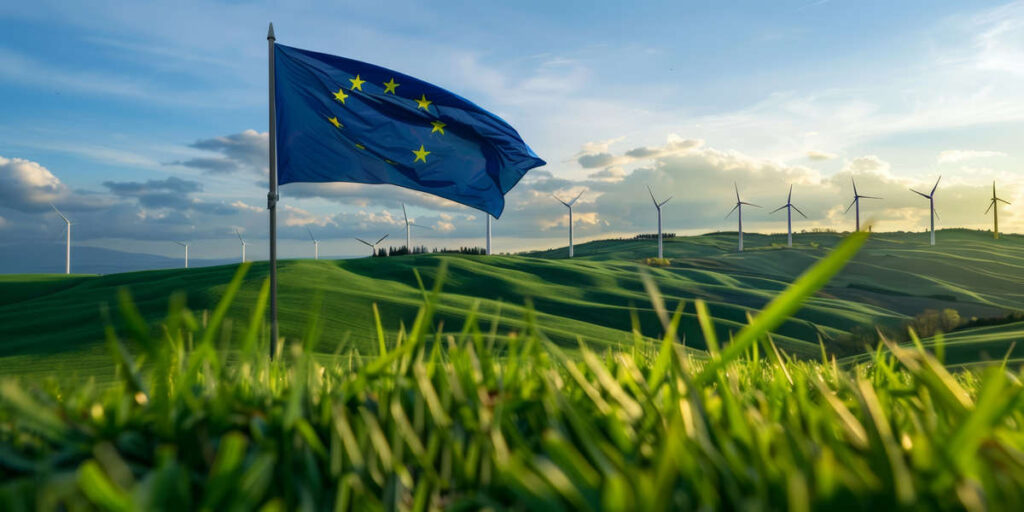Adobe: 585411388
Turbulence in politics and the global economy is aggravating the rough edges of the Green Deal, which as well as being a heavy burden for the industries and energy sectors of individual member states could also become an open route to power for far-right political forces
Few doubt the fact that the EU’s brand colour is green. At the end of 2019, the European Commission announced the Green Deal, its flagship political policy which was nothing short of a new, technologically-based industrial revolution linked to renewables and clean technologies. The Green Deal was a roadmap for developing legislative initiatives and strategies in the energy sector, industry, construction, agriculture and other spheres. The European Commission established the Green Deal in response to problems linked to the climate and environment, and also as a “new growth strategy”, which should lead to EU carbon neutrality by 2050 – the ultimate aim of the Green Deal.
Having made the Green Deal a priority, President of the European Commission Ursula von der Leyen gave a clear political direction to her mandate, which was aimed at securing the support of both the European public and various political elements that consider action to tackle climate change essential.
Ahead of elections to the European Parliament and a new political cycle on the continent, it is worth analysing the success of this policy and what it has given Europe.
Cutting emissions: target not quite hit, but nearly there
Credit must be given for the ambition of the European Commission, which has continuously raised targets on cutting emissions. For many in industry these appear too high, but thanks to bold – and frankly often very expensive measures – significant reduction in emissions has been achieved.
Emissions of greenhouse gases in EU countries in 2022 were 32.5% lower than 1990 levels. As forecast by scientists from the Global Carbon Project, the EU was also able to make a substantial cut in emissions of five percentage points in 2023. Such a substantial reduction in emissions is the result of both progress in climate policy and high energy prices after the start of the war in Ukraine.
Significant subsidies for renewables are also driving success in this area. On average, the share of renewables in European energy has grown 0.67 percentage points each year to hit 21.8% in 2021. In 2022, the share of energy generated from renewables rose to 23%.

Adobe: 768698203
Nonetheless, the pace of decarbonization is not sufficient. As Politico reported in January, the EU’s Scientific Advisory Board on Climate Change – a 15-member panel of top climate experts charged with providing advice on EU policy – has laid out a host of recommendations for course corrections across every sector of the EU economy and urged new engagement from policymakers. Experts believe that the rate of decarbonization should be doubled right now. This is the only way the EU will be able to hit its 2030 goal of cutting emissions to 55% below 1990 levels. Current national plans are only sufficient to reach a 49-51% decrease. Progress on the EU’s legally mandated goal of net zero by 2050 is still worse, with the bloc currently missing this target by a wide margin. Incidentally, at the end of 2023 the European Environment Agency assessed that current policies would cut emissions in 2030 by just 43%.
In the same document, climate experts also support action to “almost fully phase out the use of coal and fossil gas in public electricity and heat generation” by 2040 and criticize the EU for inadequate measures to combat the use of gas. “The EU’s stance on the role of fossil gas is ambiguous, leading to costly infrastructural and institutional lock-ins, and delayed fossil fuel phase-out,” the authors state.
This last issue clearly can’t be solved purely through the will of European institutions: they will have to step into territory which could lead the Green Deal into deadlock, namely the domestic energy policies of member states.
The problem of national energy policies
There is a fundamental difference between climate and energy policy in the EU. Climate policy has been very successfully regulated at an EU level, particularly with the advent of the Green Deal and unified targets on cutting emissions. At the same time, energy policy remains fragmented: choices about energy sector structure are explicitly acknowledged to be a national prerogative.
To fully control national energy systems, the EU would have to extend the system for trading carbon emissions quotas to all branches of the economy. It would be impossible to do this without infringing the energy sovereignty of member states. There is also the question of whether the bloc would be able to create safety mechanisms to prevent the EU’s Emissions Trading Scheme causing a disruptive spike in energy prices.
Green Deal’s effectiveness declines
The Green Deal was developed at a time when Europe and indeed the world in general were very different. National governments could not have imagined the extent of the energy crisis that began in 2022, and the degree to which production and trading chains and the infrastructural landscape have been reorganized.
Experts believe that the Green Deal must be reformed and in many respects adapted straight away to the current political and economic situation, if at all possible. In their report entitled How Can the Green Deal Adapt to a Brutal World? Marc-Antoine Eyl-Mazzega and Diana-Paula Gherasim of the IFRI Centre for Energy identify key points that need to be addressed to adjust the Green Deal to new realities.
“Russia’s war in Ukraine, higher interest rates, inflation, strained public finances, weakened value chains, and lack of crucial skills pose unprecedented challenges,” they state. The report affirms that business and the public are dissatisfied with the situation in virtually every point of the political plan. Opposition has been demonstrated vividly by the actions of the European agricultural sector. At the beginning of 2024, farmers from all over the continent drove their tractors to the European capital Brussels in order to express their anger and disappointment.

Adobe: 496241868
Moreover, even the professional and trade association Fire Safety Europe is sounding the alarm that although essential in order to cut carbon dioxide emissions, innovations such as solar panels, heat pumps and charging stations for electric vehicles create potential fire hazards because of an increase in electrical loads and servicing problems. Existing fire risks will be intensified further because of the Green Deal’s emphasis on decarbonizing buildings by means of advanced innovations if fire safety is not taken into account, they believe.
One thing is clear: given such radical changes in the politics and economy of the region in recent years, the main Green Deal plan needs to be adapted; the Green Deal perhaps even requires a major update to avoid becoming a death sentence for whole branches of the economy. But all this will require political will. The question is whether there will be enough such will after elections to the European Parliament this June.
Vote Green?
A great deal has also changed at the political level since the last elections to the European Parliament: the electorate’s view of the climate agenda has now changed from the one that led green forces to triumph last time round.
In these circumstances, criticism from the opposition parties – first and foremost those on the far right – towards current governments is becoming ever louder, and one of the main targets of their criticism is the EU’s environmental policy.
An IPSOS opinion poll published in March showed that ahead of the elections, EU residents have started to worry less about the climate. Europeans have stopped perceiving climate change as the main threat. The mood of EU residents is markedly different from that of 2019. Five years ago, many cities saw marches in support of the planet and actions supporting renewable energy, and the main theme of the election campaign was combatting climate change.
Now, opinion polls show that while 52% consider this topic a priority, 32% see it as a secondary issue. Meanwhile, 54% of those questioned said that their purchasing power and standard of living were more important than the Green Deal.
Thus, the recently agreed EU law banning the production of cars with internal combustion engines from 2035 has become a thorny problem and a subject of criticism. Speaking on the subject, far-right politician Marine Le Pen called on member countries to “take back the power that the EU confiscated from them.”
Opposition to the Green Deal is coming not only from the French right, but from other parties in Europe. The Dutch Freedom party (PVV), which gained victory in parliamentary elections in the Netherlands in November 2023 has declared that it wants to repeal all climate laws. This is despite the Netherlands’ reputation as one of the most ambitious EU countries in the field of climate change.
This position is becoming ever more common. Centrist parties are also levelling criticism at individual aspects of the Green Deal: in its draft election manifesto, Germany’s CDU promises to scrap the EU ban on internal combustion engines. Overall, the lack of vocal calls for an aggressive climate policy in the election battle of European parties compared to 2019 is striking.
However, research on public opinion shows that flirtation with themes of abandoning the radical environmental agenda is not attracting far-right voters to mainstream parties. Instead, the right-wingers’ policy, previously considered radical, is starting to be viewed as “normal.” Furthermore, voters are giving their preference to the “original” parties that first expressed dissatisfaction with the current policy, and those in the centre who try to imitate their proposals are losing supporters. This is a very dangerous tendency, particularly ahead of the elections.
One thing is clear: the new European Commission will have to defend its Green Deal with a vengeance.

